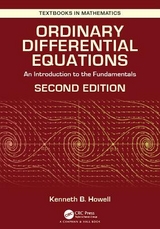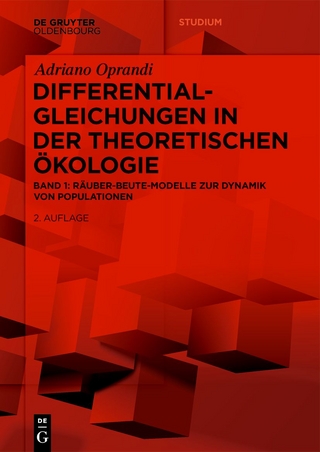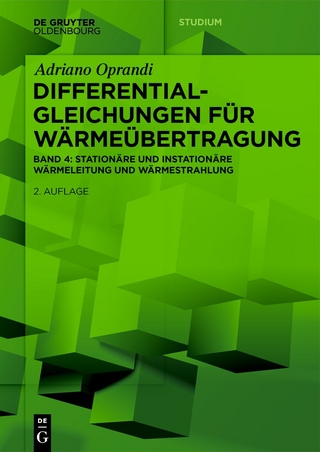
Ordinary Differential Equations
Productivity Press (Verlag)
978-1-4987-3381-6 (ISBN)
- Titel erscheint in neuer Auflage
- Artikel merken
Employs a unique expository style that explains the how and why of each topic covered
Allows for a flexible presentation based on instructor preference and student ability
Supports all claims with clear and solid proofs
Includes material rarely found in introductory texts
Ordinary Differential Equations: An Introduction to the Fundamentals also includes access to an author-maintained website featuring detailed solutions and a wealth of bonus material. Use of a math software package that can do symbolic calculations, graphing, and so forth, such as Maple™ or Mathematica®, is highly recommended, but not required.
Kenneth B. Howell earned bachelor degrees in both mathematics and physics from Rose-Hulman Institute of Technology, and master’s and doctoral degrees in mathematics from Indiana University. For more than thirty years, he was a professor in the Department of Mathematical Sciences of the University of Alabama in Huntsville (retiring in 2014). During his academic career, Dr. Howell published numerous research articles in applied and theoretical mathematics in prestigious journals, served as a consulting research scientist for various companies and federal agencies in the space and defense industries, and received awards from the College and University for outstanding teaching. He is also the author of Principles of Fourier Analysis (Chapman & Hall/CRC, 2001).
THE BASICS
The Starting Point: Basic Concepts and Terminology
Differential Equations: Basic Definitions and Classifications
Why Care about Differential Equations? Some Illustrative Examples
More on Solutions
Additional Exercises
Integration and Differential Equations
Directly-Integrable Equations
On Using Indefinite Integrals
On Using Definite Integrals
Integrals of Piecewise-Defined Functions
Additional Exercises
FIRST-ORDER EQUATIONS
Some Basics about First-Order Equations
Algebraically Solving for the Derivative
Constant (or Equilibrium) Solutions
On the Existence and Uniqueness of Solutions
Confirming the Existence of Solutions (Core Ideas)
Details in the Proof of Theorem 3.1
On Proving Theorem 3.2
Appendix: A Little Multivariable Calculus
Additional Exercises
Separable First-Order Equations
Basic Notions
Constant Solutions
Explicit Versus Implicit Solutions
Full Procedure for Solving Separable Equations
Existence, Uniqueness, and False Solutions
On the Nature of Solutions to Differential Equations
Using and Graphing Implicit Solutions
On Using Definite Integrals with Separable Equations
Additional Exercises
Linear First-Order Equations
Basic Notions
Solving First-Order Linear Equations
On Using Definite Integrals with Linear Equations
Integrability, Existence and Uniqueness
Additional Exercises
Simplifying Through Substitution
Basic Notions
Linear Substitutions
Homogeneous Equations
Bernoulli Equations
Additional Exercises
The Exact Form and General Integrating Factors
The Chain Rule
The Exact Form, Defined
Solving Equations in Exact Form
Testing for Exactness—Part I
"Exact Equations": A Summary
Converting Equations to Exact Form
Testing for Exactness—Part II
Additional Exercises
Slope Fields: Graphing Solutions without the Solutions
Motivation and Basic Concepts
The Basic Procedure
Observing Long-Term Behavior in Slope Fields
Problem Points in Slope Fields, and Issues of Existence and Uniqueness
Tests for Stability
Additional Exercises
Euler’s Numerical Method
Deriving the Steps of the Method
Computing via Euler’s Method (Illustrated)
What Can Go Wrong
Reducing the Error
Error Analysis for Euler’s Method
Additional Exercises
The Art and Science of Modeling with First-Order Equations
Preliminaries
A Rabbit Ranch
Exponential Growth and Decay
The Rabbit Ranch, Again
Notes on the Art and Science of Modeling
Mixing Problems
Simple Thermodynamics
Appendix: Approximations That Are Not Approximations
Additional Exercises
SECOND- AND HIGHER-ORDER EQUATIONS
Higher-Order Equations: Extending First-Order Concepts
Treating Some Second-Order Equations as First-Order
The Other Class of Second-Order Equations "Easily Reduced" to First-Order
Initial-Value Problems
On the Existence and Uniqueness of Solutions
Additional Exercises
Higher-Order Linear Equations and the Reduction of Order Method
Linear Differential Equations of All Orders
Introduction to the Reduction of Order Method
Reduction of Order for Homogeneous Linear Second-Order Equations
Reduction of Order for Nonhomogeneous Linear Second-Order Equations
Reduction of Order in General
Additional Exercises
General Solutions to Homogeneous Linear Differential Equations
Second-Order Equations (Mainly)
Homogeneous Linear Equations of Arbitrary Order
Linear Independence and Wronskians
Additional Exercises
Verifying the Big Theorems and an Introduction to Differential Operators
Verifying the Big Theorem on Second-Order, Homogeneous Equations
Proving the More General Theorems on General Solutions and Wronskians
Linear Differential Operators
Additional Exercises
Second-Order Homogeneous Linear Equations with Constant Coefficients
Deriving the Basic Approach
The Basic Approach, Summarized
Case 1: Two Distinct Real Roots
Case 2: Only One Root
Case 3: Complex Roots
Summary
Additional Exercises
Springs: Part I
Modeling the Action
The Mass/Spring Equation and Its Solutions
Additional Exercises
Arbitrary Homogeneous Linear Equations with Constant Coefficients
Some Algebra
Solving the Differential Equation
More Examples
On Verifying Theorem 17.2
On Verifying Theorem 17.3
Additional Exercises
Euler Equations
Second-Order Euler Equations
The Special Cases
Euler Equations of Any Order
The Relation between Euler and Constant Coefficient Equations
Additional Exercises
Nonhomogeneous Equations in General
General Solutions to Nonhomogeneous Equations
Superposition for Nonhomogeneous Equations
Reduction of Order
Additional Exercises
Method of Undetermined Coefficients (aka: Method of Educated Guess)
Basic Ideas
Good First Guesses for Various Choices of g
When the First Guess Fails
Method of Guess in General
Common Mistakes
Using the Principle of Superposition
On Verifying Theorem 20.1
Additional Exercises
Springs: Part II
The Mass/Spring System
Constant Force
Resonance and Sinusoidal Forces
More on Undamped Motion under Nonresonant Sinusoidal Forces
Additional Exercises
Variation of Parameters (A Better Reduction of Order Method)
Second-Order Variation of Parameters
Variation of Parameters for Even Higher Order Equations
The Variation of Parameters Formula
Additional Exercises
THE LAPLACE TRANSFORM
The Laplace Transform (Intro)
Basic Definition and Examples
Linearity and Some More Basic Transforms
Tables and a Few More Transforms
The First Translation Identity (And More Transforms)
What Is "Laplace Transformable"? (and Some Standard Terminology)
Further Notes on Piecewise Continuity and Exponential Order
Proving Theorem 23.5
Additional Exercises
Differentiation and the Laplace Transform
Transforms of Derivatives
Derivatives of Transforms
Transforms of Integrals and Integrals of Transforms
Appendix: Differentiating the Transform
Additional Exercises
The Inverse Laplace Transform
Basic Notions
Linearity and Using Partial Fractions
Inverse Transforms of Shifted Functions
Additional Exercises
Convolution
Convolution, the Basics
Convolution and Products of Transforms
Convolution and Differential Equations (Duhamel’s Principle)
Additional Exercises
Piecewise-Defined Functions and Periodic Functions
Piecewise-Defined Functions
The "Translation along the -T -Axis" Identity
Rectangle Functions and Transforms of More Piecewise-Defined Functions
Convolution with Piecewise-Defined Functions
Periodic Functions
An Expanded Table of Identities
Duhamel’s Principle and Resonance
Additional Exercises
Delta Functions
Visualizing Delta Functions
Delta Functions in Modeling
The Mathematics of Delta Functions
Delta Functions and Duhamel’s Principle
Some "Issues" with Delta Functions
Additional Exercises
POWER SERIES AND MODIFIED POWER SERIES SOLUTIONS
Series Solutions: Preliminaries
Infinite Series
Power Series and Analytic Functions
Elementary Complex Analysis
Additional Basic Material That May Be Useful
Additional Exercises
Power Series Solutions I: Basic Computational Methods
Basics
The Algebraic Method with First-Order Equations
Validity of the Algebraic Method for First-Order Equations
The Algebraic Method with Second-Order Equations
Validity of the Algebraic Method for Second-Order Equations
The Taylor Series Method
Appendix: Using Induction
Additional Exercises
Power Series Solutions II: Generalizations and Theory
Equations with Analytic Coefficients
Ordinary and Singular Points, the Radius of Analyticity, and the Reduced Form
The Reduced Forms
Existence of Power Series Solutions
Radius of Convergence for the Solution Series
Singular Points and the Radius of Convergence
Appendix: A Brief Overview of Complex Calculus
Appendix: The "Closest Singular Point"
Appendix: Singular Points and the Radius of Convergence for Solutions
Additional Exercises
Modified Power Series Solutions and the Basic Method of Frobenius
Euler Equations and Their Solutions
Regular and Irregular Singular Points (and the Frobenius Radius of Convergence)
The (Basic) Method of Frobenius
Basic Notes on Using the Frobenius Method
About the Indicial and Recursion Formulas
Dealing with Complex Exponents
Appendix: On Tests for Regular Singular Points
Additional Exercises
The Big Theorem on the Frobenius Method, with Applications
The Big Theorems
Local Behavior of Solutions: Issues
Local Behavior of Solutions: Limits at Regular Singular Points
Local Behavior: Analyticity and Singularities in Solutions
Case Study: The Legendre Equations
Finding Second Solutions Using Theorem 33.2
Additional Exercises
Validating the Method of Frobenius
Basic Assumptions and Symbology
The Indicial Equation and Basic Recursion Formula
The Easily Obtained Series Solutions
Second Solutions When r1 = r2
Second Solutions When r1 – r2 = K
Convergence of the Solution Series
SYSTEMS OF DIFFERENTIAL EQUATIONS (A BRIEF INTRODUCTION)
Systems of Differential Equations: A Starting Point
Basic Terminology and Notions
A Few Illustrative Applications
Converting Differential Equations to First-Order Systems
Using Laplace Transforms to Solve Systems
Existence, Uniqueness and General Solutions for Systems
Single Nth-order Differential Equations
Additional Exercises
Critical Points, Direction Fields and Trajectories
The Systems of Interest and Some Basic Notation
Constant/Equilibrium Solutions
"Graphing" Standard Systems
Sketching Trajectories for Autonomous Systems
Critical Points, Stability and Long-Term Behavior
Applications
Existence and Uniqueness of Trajectories
Proving Theorem 36.2
Additional Exercises
Appendix: Author’s Guide to Using This Text
Overview
Chapter-by-Chapter Guide
Answers to Selected Exercises
| Erscheinungsdatum | 31.01.2016 |
|---|---|
| Reihe/Serie | Textbooks in Mathematics |
| Zusatzinfo | 3 Tables, black and white; 94 Illustrations, black and white |
| Verlagsort | Portland |
| Sprache | englisch |
| Maße | 178 x 254 mm |
| Gewicht | 1678 g |
| Themenwelt | Mathematik / Informatik ► Mathematik ► Analysis |
| Naturwissenschaften ► Physik / Astronomie | |
| ISBN-10 | 1-4987-3381-6 / 1498733816 |
| ISBN-13 | 978-1-4987-3381-6 / 9781498733816 |
| Zustand | Neuware |
| Informationen gemäß Produktsicherheitsverordnung (GPSR) | |
| Haben Sie eine Frage zum Produkt? |
aus dem Bereich



